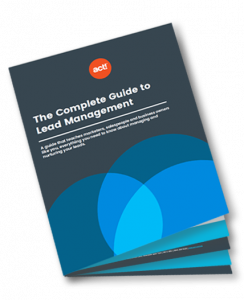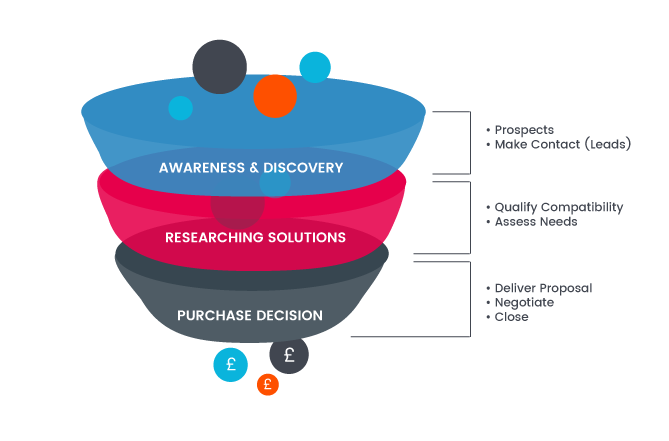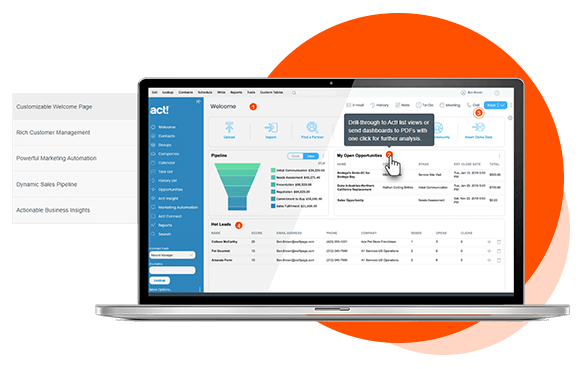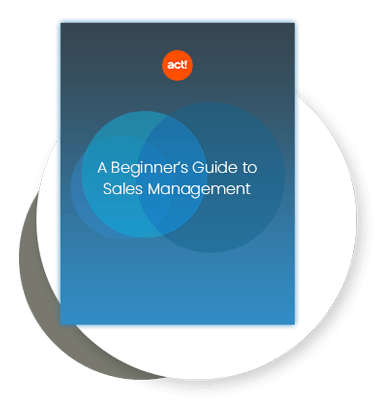What is a sales funnel?
Understand what a sales funnel is and how it can define your sales process
- 1. Sales funnel explained: How does it work?
- 2. Why do you need a sales funnel?
- 3. What are the stages of a sales funnel?
- 4. How do I create a sales funnel from scratch?
- 5. How do I optimise my sales funnel?
-
More questions?
Visit our Learning Centre -
Start Creating More Meaningful Relationships With Act!
Start your 14 day free trial today. No download or credit card required.
Start Free Trial
A sales funnel is the process prospects go through to become a customer. Each stage of the funnel takes the buyer one step closer to making a purchase. A well-planned sales funnel will define the actions your business needs to take to push prospects to the next stage.
The buying process is described as a funnel because it starts by attracting many people, before narrowing them down until you are left only with those who buy your product.
This drop off is inevitable — you will never be able to convert everyone. However, effective funnels will turn the highest number of people possible into buyers. Businesses should continually optimise and experiment with their funnel to make it more effective.
Sales funnel explained: How does it work?
Every one of your customers has been through a process that ended with them buying. This process involves them discovering your brand, finding out more about your product or service, deciding to buy, and then actually doing so.
For some products—typically lower-priced, consumer goods—this process can happen in a matter of minutes.
A customer may be browsing social media, see an advert for a pair of shoes, click on the link to read more about the product, decide they are a good fit for their needs, and then buy them. For these products, the sales funnel is straightforward, involving little more than an eCommerce store and a way of attracting customers to it.
Although, a company can still optimise the funnel by providing an excellent customer experience and creating opportunities to upsell the original item.
Other products have far more complicated funnels. Selling high-ticket enterprise software often involves multiple layers, such as email marketing, webinars, sales calls, downloadable resources, and in-person presentations. In these cases, it can take months for a buyer to go from being a prospect to a customer.
The key is to create a sales funnel that is effective at guiding potential customers through the different stages of the funnel to a point where they are ready to buy your product or service.
68% of businesses fail to identify and measure their sales funnels, which results in 79% of leads never converting into sales.1
Why do you need a sales funnel?
All businesses that make sales have some form of marketing sales funnel, even if they have not defined it.
A website for a service that attracts people via word-of-mouth is a basic sales funnel, as is using search ads to direct people to an eCommerce store.
While some businesses see success with these strategies, many others would benefit from creating a funnel that better guides users.
The service-based business above, for example, may find success by creating an email list that people who visit the site can sign up to, even if they are not yet ready to buy. They can then work on nurturing leads via email until they make a purchase.
Here are some reasons why you should create an effective sales funnel.
A focused sales and marketing strategy
Putting in place a dedicated sales funnel means you are no longer relying on a scattergun approach to selling your product. Instead, you have laid out steps and actions to take at each stage of the process. Defining your strategy is the first step, and all the other benefits follow on from this.
More sales
As you learn which activities result in prospects buying your product, and which put them off, you can focus your efforts on sales-generating activities.
Making fewer mistakes can lead to you getting more sales from the same number of prospects, as well as getting more new leads into your funnel in the first place.
A better sales funnel can also help you earn more revenue per sale. For example, by adding a step to your funnel that allows customers to choose add-ons related to their initial purchase, your business may be able to earn more per customer.
Increase forecast accuracy
By tracking how leads move through your sales funnel, your company can make better predictions about future purchases. This can help you make decisions around cashflow, budgeting, and demand.
If you know that on average 10% of people who sign up to your mailing list ultimately buy from you, you can estimate how many sales you will make based on the number of new subscribers you get every day.
Higher profit margins
Having a deeper understanding of your sales funnel lets you make better customer acquisition cost estimates. This can show you which methods of gaining customers are the most profitable.
Imagine you are spending on both Google and Instagram ads. If you find it costs £10 to gain a customer on Google and only £9 to acquire a customer on Instagram, you can focus on the later, thus increasing profitability.
This is a simple example, but the idea is sound: look at where you are spending money and what is effective to reduce costs and increase profitability.
You can also increase profit margins by testing your individual sales funnel stages. If you A/B test two landing pages and find that one converts at a higher rate, you can increase sales without spending more on customer acquisition.
Struggling to convert?
Better lead management can help. Click here to receive your complete guide to lead management.

What are the decision stages of a sales funnel?
A basic sales funnel has three stages:
- Top of the funnel: Awareness and discovery
- Middle of the funnel: Researching solutions
- Bottom of the funnel: Making an educated purchase decision
This is the journey most customers will go through.
Awareness and Discovery
During the first stage of the sales funnel, the lead becomes aware of their problem and begins to look for more information. Businesses need to create content that helps them with this research and then promote it in places the lead is likely to look for answers. Some of the ways you can do so include:
- Social media adverts
- Google search adverts
- Content marketing and a search engine optimisation strategy (SEO)
- Being active on social media
- Outreach, such as appearing on other websites or podcasts
- Ads in traditional media (T.V., radio, billboards, etc.)
Once the lead is on your website, use a lead magnet to encourage them to take the first step in the funnel. This could be a free trial of your product, an invitation to a webinar, downloadable content, or anything else that you think might convince them to hand over their email address so sales can contact them later in the funnel.
Researching Solutions
During the second stage of the sales funnel, the sales team needs to follow up with the prospect to learn more about their needs and challenges. Sales reps may contact prospects via email, phone or online calls, or meetings to ask them questions that will help them qualify the lead and identify if their offer is a good fit.
Reps can then point them towards content that shows how the product or service helps with their specific problem.
Types of content that can be useful at this stage include:
- In-depth guides to the product
- Checklists
- Social proof or case studies that show how the product has helped similar businesses
Purchase Decision Stage
During the final stage of the funnel, the lead is ready to select a solution to their problem. The role of the sales team is to get the purchase over the line. They can help the prospect finalise their buying decision by addressing any remaining barriers to sale.
Content that can help at this stage includes testimonials, pricing pages, FAQs, and comparisons with competing products.
At this point, the sales team may make a proposal and negotiate with the prospect to ensure they get a deal over the line that both parties are happy with.

How do I create a sales funnel from scratch?
If your business does not have a defined sales funnel or if you’re just starting out, you’ll need to create one from scratch.
These are steps that will show you how to create a sales funnel. This is a generalised guide—the exact steps you will take will depend on your product and your sales cycle.
It is worth noting that sales funnel definitions differ for different people. For some, it includes all your marketing efforts, while for others, it is just the final stages of the funnel that deals with converting the customer.
1. Identify your target customer
The first challenge to overcome is how to get people into your funnel in the first place. Consider who your target customer is and how they are likely to find your product. If you are targeting executives at large companies, Instagram ads may not be the best choice. Becoming active on LinkedIn may be more effective. If you have created buyer personas, now could be a good time to use them as inspiration.
2. Bring people into your funnel
You can use a lead magnet to bring people into your funnel. Create an offer that will convince prospects to hand over their email address. This could be a downloadable resource that teaches more about the topic of the page they landed on, a free tool that can help them with their problem, or the option to sign up to your email newsletter. It is essential that you tailor the offer to fit the motivation of the website visitors.
3. Nurture your leads via email
Now you have an email address; the prospect is in your sales funnel. The key is to convince them to go from someone who simply wanted a free resource, to someone who is considering your product. You can do this by sending your leads more information. You can use sales and marketing automation tools to send content that highlights how your product solves their problem. Think about case studies and in-depth guides to your product’s features.
4. Create an effective conversion process
At the conversion stage, the key is to get the prospect to take the final steps in the customer journey. One way you can do this is to create compelling sales pages, FAQs, and other conversion-centric content that sales staff can show leads. This is just a basic overview of how to create a sales funnel. For a more detailed guide, check out our article on sales funnel templates.
Act! helps you build and optimise your sales funnel

Try Act! free for 14 days and find out how.
How do I optimise my sales funnel?
Sales funnels are useful because they give businesses and sales teams a defined strategy they can use to generate sales. Once you have set up the basic version of your funnel, you should continue to add to it and test it to optimise each stage. Here are ways you can optimise your funnel.
1. Create more targeted content for each stage of the funnel
When you first set up your funnel, you will likely do so in a generalised way that targets a high number of customers. For example, to get email addresses, you may create a downloadable resource that you can use across your whole website.
A more effective strategy is to create targeted content for either each page or each subset of visitors. This content is more likely to appeal to specific groups of people and, therefore, get them into the top of your funnel.
2. Experiment with new strategies
Just because a strategy is successful doesn’t mean that it is either the best or the only method that will work. While you don’t want to move away from things that are working, once your funnel is set up you can still experiment with other strategies.
For example, while you may find that social ads are an effective way of getting people into your funnel, you may be able to attract a different type of customer by creating informative YouTube videos, or by starting to network on LinkedIn.
Dipping your toes into new strategies allows you to test whether they have potential and, if they do, pour in resources.
3. A/B test existing material
A/B testing is an important way to optimise specific parts of your sales funnel by testing out two versions to see which is better.
Imagine you are directing users to a landing page. It is performing well, but you feel it could be doing better.
Instead of swapping out the landing page for a different one, a better option would be to create a new landing page that you think will be more effective and then send traffic to each page.
You can then test conversion rates and see if the new page actually performs as you think it will. If it does, great. If it does not, you can easily switch back to sending all your traffic to the existing page.

Wrapping up
A sales funnel has many benefits for businesses that use them. They define sales processes and allow sales teams to optimise each step of the journey. This can ultimately result in more sales and profit for your business.
Hopefully, this article will have shown you how to build a sales funnel. If you need more information, we have plenty of resources that can help. Check them out below:
